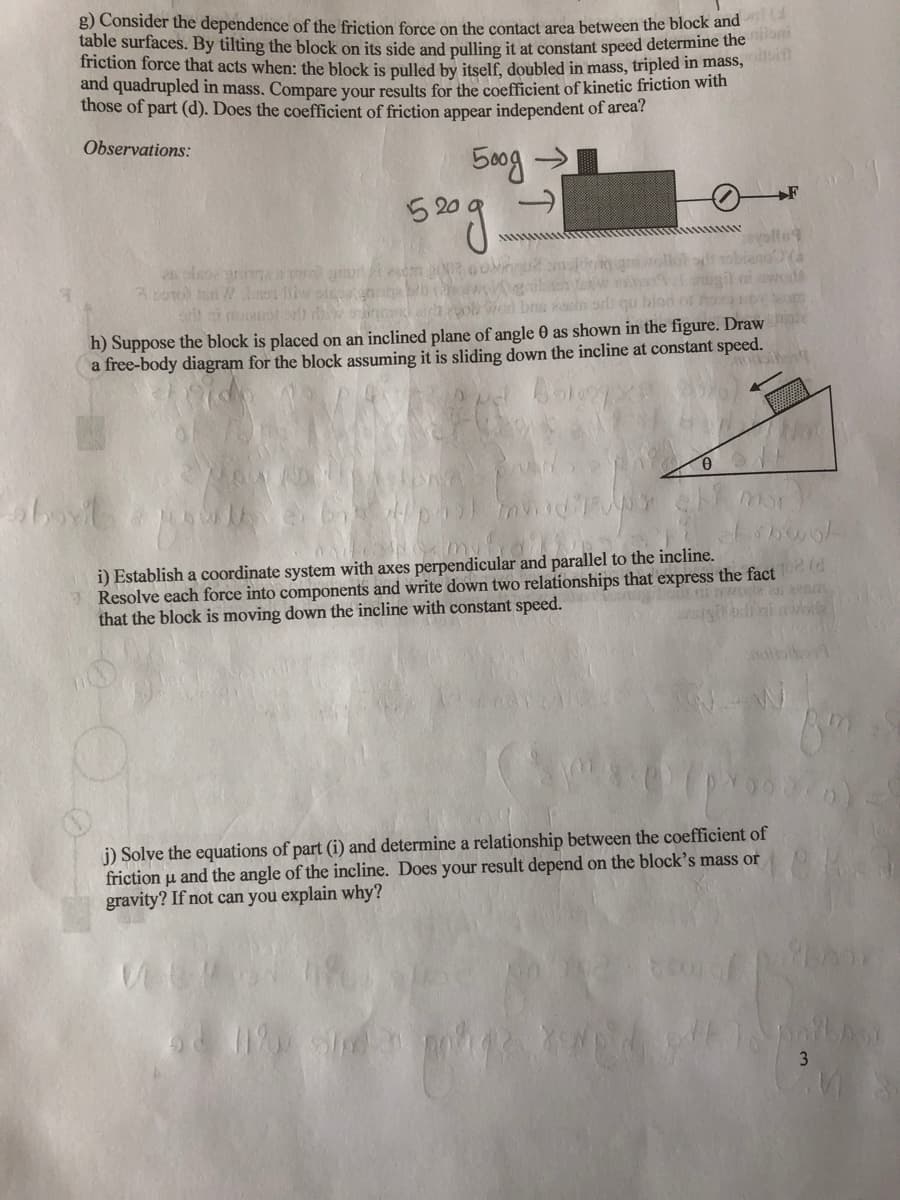h) Suppose the block is placed on an inclined plane of angle 0 as shown in the figure. Draw a free-body diagram for the block assuming it is sliding down the incline at constant speed. Mor i) Establish a coordinate system with axes perpendicular and parallel to the incline. Resolve each force into components and write down two relationships that express the fact that the block is moving down the incline with constant speed. j) Solve the equations of part (i) and determine a relationship between the coefficient of friction u and the angle of the incline. Does your result depend on the block's mass or gravity? If not can you explain why?
h) Suppose the block is placed on an inclined plane of angle 0 as shown in the figure. Draw a free-body diagram for the block assuming it is sliding down the incline at constant speed. Mor i) Establish a coordinate system with axes perpendicular and parallel to the incline. Resolve each force into components and write down two relationships that express the fact that the block is moving down the incline with constant speed. j) Solve the equations of part (i) and determine a relationship between the coefficient of friction u and the angle of the incline. Does your result depend on the block's mass or gravity? If not can you explain why?
Physics for Scientists and Engineers: Foundations and Connections
1st Edition
ISBN:9781133939146
Author:Katz, Debora M.
Publisher:Katz, Debora M.
Chapter6: Applications Of Newton’s Laws Of Motion
Section: Chapter Questions
Problem 33PQ
Related questions
Question

Transcribed Image Text:g) Consider the dependence of the friction force on the contact area between the block and
table surfaces. By tilting the block on its side and pulling it at constant speed determine the
friction force that acts when: the block is pulled by itself, doubled in mass, tripled in mass,
and quadrupled in mass. Compare your results for the coefficient of kinetic friction with
those of part (d). Does the coefficient of friction appear independent of area?
Observations:
500g >
+F
52
blod o
h) Suppose the block is placed on an inclined plane of angle 0 as shown in the figure. Draw
a free-body diagram for the block assuming it is sliding down the incline at constant speed.
i) Establish a coordinate system with axes perpendicular and parallel to the incline.
Resolve each force into components and write down two relationships that express the fact
that the block is moving down the incline with constant speed.
j) Solve the equations of part (i) and determine a relationship between the coefficient of
friction u and the angle of the incline. Does your result depend on the block's mass or
gravity? If not can you explain why?
3
Expert Solution
This question has been solved!
Explore an expertly crafted, step-by-step solution for a thorough understanding of key concepts.
This is a popular solution!
Trending now
This is a popular solution!
Step by step
Solved in 2 steps with 2 images

Knowledge Booster
Learn more about
Need a deep-dive on the concept behind this application? Look no further. Learn more about this topic, physics and related others by exploring similar questions and additional content below.Recommended textbooks for you

Physics for Scientists and Engineers: Foundations…
Physics
ISBN:
9781133939146
Author:
Katz, Debora M.
Publisher:
Cengage Learning

Classical Dynamics of Particles and Systems
Physics
ISBN:
9780534408961
Author:
Stephen T. Thornton, Jerry B. Marion
Publisher:
Cengage Learning

College Physics
Physics
ISBN:
9781938168000
Author:
Paul Peter Urone, Roger Hinrichs
Publisher:
OpenStax College

Physics for Scientists and Engineers: Foundations…
Physics
ISBN:
9781133939146
Author:
Katz, Debora M.
Publisher:
Cengage Learning

Classical Dynamics of Particles and Systems
Physics
ISBN:
9780534408961
Author:
Stephen T. Thornton, Jerry B. Marion
Publisher:
Cengage Learning

College Physics
Physics
ISBN:
9781938168000
Author:
Paul Peter Urone, Roger Hinrichs
Publisher:
OpenStax College